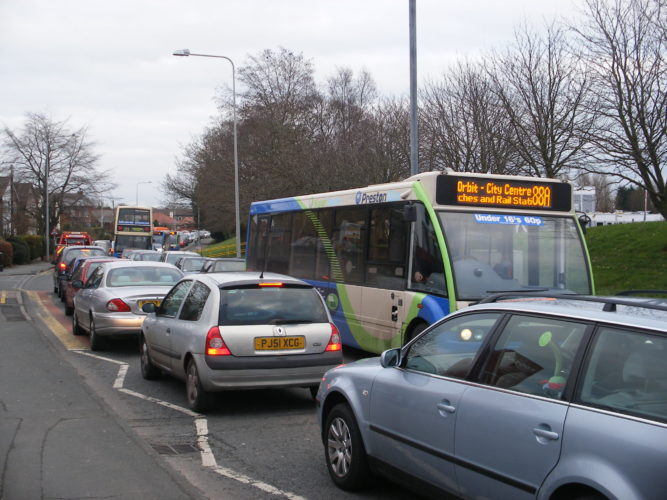
Hospital Car Parking – Is there Room for the Bus?
TAS Principal Consultant, John Atkins
The rare opportunity to announce measures that benefit motorists is understandably seized upon by vote-hungry politicians, and so it is no surprise that a 2019 Conservative election pledge to abolish car parking fees at hospitals was widely reported. And with the resounding return of another Conservative administration, we can expect the bulk of the manifesto promises to come to fruition – including the proposed policy on NHS parking. But will motorists feel any benefit? Moreover, is the policy really new?
The NHS is a regular hook upon which pre-election promises by all parties are hung to reassure the voters that the institution is secure and “in safe hands”. This almost always comes down to money, of which the Conservatives were pledging an extra £34bn per year.
The manifesto stated that: “We will end unfair hospital car parking charges by making parking free for those in greatest need…This will eliminate costs for those in need, while making sure there are enough spaces for everyone.” Those in ‘greatest need’ are in fact the minority of hospital car parkers – most people will still have to pay the prevailing tariff.
And voters in Scotland and Wales have heard all this before – ten years ago. Welsh hospitals have theoretically offered free parking for all since 2008, although that policy took ten years to be fully implemented. Scotland has been somewhat in abeyance with some sites already offering free parking but others still charging due to being locked into long term contracts with car parking providers which are too expensive to buy out of.
That it is also unfair for those needing to reach the hospital where there happens to be an inadequate bus network was not alluded to directly in the Conservative manifesto. Buses, however, are to be subject of some upgrading and improvement measures, with the bold assertion that city regions will be funded to “upgrade their bus, tram and train services to make them as good as London’s.” As the majority of NHS sites are outside the city regions, we can assume that bus service links to many hospitals will not benefit at all.

Buses in traffic on Sharoe Green Lane outside Royal Preston Hospital
Fundamentally, encouraging more cars can only mean increased congestion, which will further retard the efficiency and attractiveness of those current bus services serving hospitals. And at the sharp end of the hospital access priority, more cars will have the effect of delaying ambulances which directly compromises healthcare standards.
In reality the plan is to offer free parking as a concession to specific qualifying patients, visitors and staff. And if this move is seen as creating more demand for the already inadequate parking space provision at most hospital sites, an additional capital investment is promised to create more car parks, whether or not the surrounding road network is able to handle the additional traffic.
A less reported detail (although clearly stated in the easily-overlooked manifesto annex document ‘Costings’) was the cost of the ‘free’ parking over four years: £384m revenue + £257m capital to build the new car parks. This amounts to £641m over four years – or, to use a popular illustrative comparator, the equivalent cost of 4,000 additional nurses (at £40k per year).
So what is new about this? The existing Department of Health & Social Care policy on transport to hospitals dates from before 2015 and the main principle is that “NHS organisations should work with their patients and staff, local authorities and public transport providers to make sure that users can get to the site.”
This reflects a more holistic, multi-modal approach to alleviating parking and improving access to hospitals that is lacking in the Conservative manifesto.
It is interesting to compare the policy on car parking that has been in place for at least five years with the 2019 manifesto pledge.
| 2015 Directive to NHS Organisations | 2019 Manifesto Pledge |
“Concessions, including free or reduced charges or caps, should be available for the following groups:
|
Free parking “for those in greatest need, including:
|
This 2015 list of parking concession beneficiaries would appear to be the exact groups that the 2019 manifesto is seeking to help, which suggests that there is already an active policy to offer free or subsidised charge parking to those most in need. So what in the manifesto is new? The somewhat emotive reference to “parents of sick children” (children of sick parents could be equally deserving) and “free” has replaced “free or reduced”. It is reported that many NHS Trusts have not implemented the 2015 policy, and over 150 sites are said to even levy charges on Blue Badge holders. So maybe the Conservative pledge is not so much a new policy but an effort to make an old policy work properly.
The £384m cost is presented as an additional budgetary allocation, which might be taken up with the concession or used to plug the gap in revenue loss – but if the policy is already in place, is this much new cash is actually needed? It could also be, as was the case in Scotland, that long term private sector contractors of parking services would have to be compensated.
The £257m capital for additional car parks is new money, however, and would appear to be made available to dispel the obvious retort that more parking spaces are needed, not free parking spaces. This shows that an increase in car journeys is anticipated – the particulate emission and congestion costs of this increase, of course, aren’t factored as a financial debit. ‘Smoke free’ hospital sites apparently don’t include vehicle emissions. Local Councils struggling to meet air quality targets might be expected to take a dim view of this. But how much more valuable would have been a £257m investment in bus priority and infrastructure enhancements at hospital sites instead?
Finding the space to accommodate more cars will be less easy. How many hospital sites have the elbow room to expand on-site parking? Can existing multi-storey car parks be elevated further with additional levels? James Cook Hospital in Middlesbrough, for example, has some adjacent sports fields. Ditto at Cheltenham General Hospital which abuts the open green space of Standford Park (part of which has already been purloined for a helicopter landing site). Are these precious amenities to be sacrificed in the roll out of the policy? Hospital sites have developed incrementally – new units and facilities are squeezed into available space over time, and many hospitals have long ago fully exploited the limits of their geographic boundaries. Many already rely on satellite parking areas that require shuttle buses or Park and Ride (if you’re lucky) or long walks (if you aren’t). So in practice, buses will have to figure in any solution to the parking problem, because in likelihood new car parks will not be near enough to allow walking access to the hospitals.
There are 1,250 hospitals in the UK and an equal split of the whole budget would provide £128,000 per year per site, which could be used to improve bus services and bus priority access arrangements but is admittedly a small sum with which to make an impact. An equal split of the capital alone for new car parks would yield a mere £206,000 per site which would provide very little indeed. But the allocation could be targeted at, say, 250 hospital sites which have a critical problem, with a much more potent £641,000 per year to play with. In Preston, for example, the junctions that serve the Royal Preston Hospital and some of the main A6 route north of the town centre are heavily congested – cars, buses, and ambulances are equally retarded, especially at peak times. Creating an effective Park & Ride scheme in the North of the city could help to resolve this.
Some examples of hospitals with ongoing transport and access problems:
- Sheffield: Access into the Northern General in Sheffield by bus has always been problematic. It is a massive site but a significant walk from the main volume of buses on Barnsley Road. Last September First changed one of its Barnsley Road routes – the 11a – to go into the hospital site, offering a fifteen-minute headway direct from the city centre. However, First has now told its users that “buses are temporarily suspended from directly serving Northern General Hospital as permission has been refused to use the hospital grounds.”
- Barnsley: “South Yorkshire’s Active Travel Commissioner has been invited to help find solutions to traffic congestion around Barnsley Hospital which has left air pollution in the area nudging dangerous levels. Councillors representing the area have already suggested a park-and-ride arrangement as a means of reducing traffic…but no progress has been made with those ideas.” (see – Yorkshire Post 9th September 2019)
- Wrexham: An independent report at the Wrexham Maelor hospital site found that “of the 1600 parking spaces available at the hospital… peak times demand for space can exceed those spaces by around 10%. Roll forward three years to April 2019 when it was confirmed by Betsi Cadwaladr that several options had been put in place and other were being looked at – including increasing the car parking capacity at the site. A spokesperson for the health board said: “We’d urge anyone visiting Wrexham Maelor Hospital to factor the potential traffic congestion during peak hours. We understand that parking is a challenge on site, and have made efforts to ease pressures, including introducing a drop-off area and promoting alternative travel arrangements to the site, such as cycling and car share schemes.” (see – wrexham.com – 13th January 2020)
Substantial allocated funding to apply to all aspects of transport and access (and not just car parking) could go some way to alleviating the problems noted above.
More useful, perhaps, would be measures to ensure that the NHS does engage properly with patients and staff, local authorities and public transport providers (as the 2015 directive expects) and
a) produce a travel plan for its hospitals that encourages sustainable modes and
b) ensures that the plan is made to work.
Undoubtedly, the car parking arrangements at many hospitals are dire and can no doubt be improved, but this should not happen at the expense of bus users, cyclists and pedestrians.
TAS Partnership has worked with a number of NHS bodies to improve site access and it will be interesting to see how the new financial allocation (which kicks in from April 2020) works out. If the car priority is allowed to prevail, then the demand for parking will even further outrun supply (new car parks notwithstanding), and visits to hospitals will become even more of a nightmare.




0 Comments